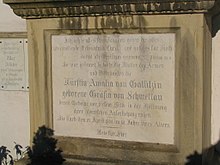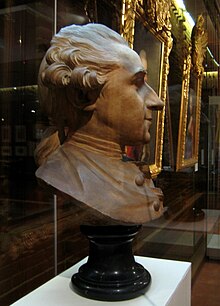Amalie von Gallitzin
Amalie von Gallitzin (born August 28, 1748 in Berlin , † April 27, 1806 in Munster ) was a "commuter" between the Enlightenment and Catholicism and a co-founder of "romantic" Catholicism. As a salonnière , she was involved in the Catholic Enlightenment in the Principality of Münster .
Life
Childhood in Prussia and wife of Dmitri Alexejewitsch Golitsyn
Amalie von Gallitzin was born as the daughter of the Prussian Field Marshal Count Samuel von Schmettau . Her father was a Protestant, her mother a Catholic, and she herself was brought up Catholic in an Ursuline convent in Breslau. Unusually educated for a woman of her time, she became court lady of Anna Elisabeth Luise von Brandenburg-Schwedt at the Prussian court in 1765 . In 1768 she married the Russian ambassador in Paris, Prince Dmitri Alexejewitsch Golitsyn (1734-1803) in Aachen . In 1768 the scientifically interested prince was appointed envoy in The Hague . Their daughter Marianne, called Mimi, was born in Berlin on December 7, 1769, and their son Dimitrij , called Mitri, was born on December 22, 1770 .
Encounter with the Enlightenment
Through her husband, Amalie von Gallitzin came into contact with the leading enlightener Voltaire and the French encyclopedists Denis Diderot and D'Alembert . Diderot had a personal impact on the princess through his writings. On June 11, 1773, Diderot left Paris for his only long journey to Saint Petersburg . In The Hague he stayed with the Russian ambassador Prince von Gallitzin and his wife Amalie am Kneuterdijk until August 20, 1773 . Diderot described her as lively, happy, witty, pretty and musical, as a woman who enjoys debating. On the way back, Diderot passed by from April 5 to October 15, 1774; he was in The Hague for a total of eight months. The princess was now living withdrawn and tried to implement Rousseau's ideal of upbringing for her own children, Marianne and Demetrius Augustinus Gallitzin . In the same year, after she separated from her husband, she moved with them to a remote house near Scheveningen , "gives this house the inscription on a shield: Niethuys (i.e. not at home), to ward off any uninvited visit". She wore simple dresses in the Greek style and had her hair cut short - contrary to the prevailing fashion. She encouraged her children to do sports, and her daughter also learned horse riding and fencing. From 1775 it was influenced by the philosophy of Frans Hemsterhuis ; She remained connected to him until the end of his life and exchanged lively letters with him. She was his muse , he called her his Diotima , she him " Socrates ". The translation of a book (1782) and their correspondence influenced early Romantics such as Friedrich Schlegel and Novalis in Göttingen.
The first time in Münster
The epoch-making school reforms introduced by Franz Freiherr von Fürstenberg in the Prince Diocese of Münster prompted the Princess to move to Münster in 1779 . She was in correspondence with prominent contemporaries, such as Johann Gottfried von Herder , Lavater and Friedrich Heinrich Jacobi . Caroline Michaelis , who later became von Schlegel and Schelling's wife , wrote about her in 1781:
- A very learned lady, dressed in the Greek fashion, with short hair, flat shoes, seldom seen without a servant, who carries half a dozen large folio volumes when she bathes in our leash in broad daylight with an entourage of 6 to 8 gentlemen, etc. Children are very lightly dressed, the son wears long trousers and a shirt instead of other clothes, and the daughter a kind of nightgown, open from top to bottom at the back, only tied once at the top. Both go barefoot, their hair not cut off, but shaved off. They are black like negroes. The princess is very pretty and has a beautiful complexion, although she exposes him a lot. [...] To raise her children, she seems to take nature as an example, without worrying that nature is sometimes a little dirty.
Amalie converted to Catholicism on August 28, 1786, which was also influenced by her correspondence with Johann Georg Hamann . On a trip to Weimar she met Goethe , who visited her in Münster in 1792. Also Matthias Claudius was their guest. She has taught Latin , Greek, English, French, German, history, geography, and mathematics , among others . In addition to her own children, she raised her niece Amalie and the son Georg Arnold of the philosopher Friedrich Heinrich Jacobi. The circle of friends included the poet and lawyer Anton Matthias Sprickmann , later sponsor of Annette von Droste zu Hülshoff , professor in Münster, Breslau and Berlin.
Return to the Church and "Familia Sacra"

From 1783, after an illness, Princess Amalie began to occupy herself with religion. During this time she was particularly influenced by the Königsberg philosopher Johann Georg Hamann , who met her in Münster in 1787/1788 and died there surprisingly; he was buried in her garden.
The preoccupation with religion, especially the influence of the director of the normal school in Münster , Bernhard Heinrich Overberg , caused the princess to return to the Catholic Church on August 28, 1786. Your house became the center of the Münster circle , affectionately and ironically called "familia sacra" by contemporaries. This group included the brothers Kaspar Max and Clemens August Droste zu Vischering , the parents of the poet Annette von Droste-Hülshoff , and later also Friedrich Leopold Graf von Stolberg .
"The Münster circle around Amalie von Gallizin was of great importance for the internal renewal of German Catholicism ."
After the French Revolution, the princess developed a wide range of charitable activities for the French emigrants.
The University and State Library of Münster dedicated an exhibition to Amalie von Gallitzin in 1998. The history of its reception was presented for the first time and the question of its significance for intellectual history was described in Markus von Hänsel-Hohenhausen: Amalia Fürstin von Gallitzin, Meaning and Effect, Notes on the 200th Anniversary of Death, Frankfurt / M. 2005.
Works
- Communications from the diary and correspondence of Princess Adelheid Amalie von Gallizin , 1868
- Correspondence and diaries of Princess Amalie von Gallitzin , ed. by Christoph Schlüter, 3 vol., 1874–76
- "Treatise on rewarding and bestafen", In: "Instructions for appropriate school lessons for school teachers in the Principality of Münster", ed. von Overberg in 1793 under his name
Portrait

Princess Gallitzin with her friends , painting by Theobald von Oer from 1864: The picture shows Princess Amalia von Gallitzin with her friends from the “familia sacra” in front of their house in Angelmodde near Münster. The painting, which is now in the possession of the diocese of Münster, was created 64 years after the historical encounter. The Berlin artist Paul Dröhmer made a large number of copperplate engravings based on this painting, which can still be found today in many public and private houses - especially in Westphalia.
The following people are shown on the painting (from left to right):
- Buchholtz, landowner on Wellbergen, humanist and friend of the princess
- von Druffel, Buchholtz's son-in-law, the princess's doctor
- Georg Kellermann, educator of Count Stolberg's sons, later dean
- Andreas Graf zu Stolberg, second son from the first marriage of the count
- Christian Graf zu Stolberg (1748–1821), son from the count's second marriage
- Sophie Countess zu Stolberg b. Countess Redern
- Friedrich Leopold Count of Stolberg-Stolberg (1750-1819)
- Adolph Baron Droste-Vischering
- Franz Freiherr von Fürstenberg (1729–1810), Canon and Minister of Münster
- Amalia Princess von Gallitzin born. Countess of Schmettau
- Bernhard Overberg (1754–1826), teacher, confessor to the princess
- Franz Freiherr Droste-Vischering (1771–1826), Canon
- Clemens August Freiherr Droste-Vischering (1773–1845), canon, later Archbishop of Cologne
- Marianne Princess Gallitzin, daughter of the Princess, later Princess von Salm-Reifferscheidt
- Caspar Max Freiherr Droste zu Vischering (1770–1846), auxiliary bishop, later bishop of Münster
- Johann Hyacinth Kistemaker , grammar school director and professor of exegesis
- Anton Matthias Sprickmann (1749–1833), poet and Prof. Dr. jur., later in Breslau and Berlin
- Theodor Katerkamp , educator of the Barons von Droste Vischering, professor of church history
- Prince Demetrius Gallitzin (1770–1840), son of the princess, later a missionary in America
literature
- Friedrich Wilhelm Bautz : Amalie von Gallitzin. In: Biographisch-Bibliographisches Kirchenlexikon (BBKL). Volume 2, Bautz, Hamm 1990, ISBN 3-88309-032-8 , Sp. 170-172.
- Hanny Brentano : Amalie Princess of Gallitzin . Herdersche Verlagshandlung, Freiburg im Breisgau 1910.
- Markus von Hänsel-Hohenhausen: Amalie Fürstin von Gallitzin, meaning and effect, comments on the 200th anniversary of death. With a contribution about Frans Hemsterhuis and the Princess by Marcel F. Fresco and with a literary miniature by Demetrius Augustin Prince von Gallitzin drawn by Ilse Pohl. Frankfurter Verlagsgruppe, Frankfurt a. M. 2006, ISBN 978-3-8267-0013-2 .
- Mathilde Köhler: Amalie von Gallitzin. A life between scandal and legend . Schöningh, Paderborn 1993, ISBN 3-506-74759-2 .
- Gisbert Kranz : Amalie von Gallitzin (1748–1806) . In: Ders .: Twelve women . Eos Verlag, St. Ottilien 1998, ISBN 3-88096-461-0 .
- Josef Bernhard Nordhoff : Gallitzin, Adelheid Amalia Princess of . In: Allgemeine Deutsche Biographie (ADB). Volume 8, Duncker & Humblot, Leipzig 1878, pp. 338-345.
- Siegfried Sudhof: The district of Münster . In: Reallexikon der deutschen Literaturgeschichte . Vol. II, 1961, p. 439 ff.
- Siegfried Sudhof: Gallitzin, Amalia Fürstin, née Countess von Schmettau. In: New German Biography (NDB). Volume 6, Duncker & Humblot, Berlin 1964, ISBN 3-428-00187-7 , pp. 51-53 ( digitized version ).
- Petra Schulz: Amalie Fürstin von Gallitzin (1748–1806): “My soul is on the tip of my pen” . 1998 (catalog accompanying the exhibition of the Westphalian Landscape Association).
- Andreas Oberdorf: Demetrius Augustinus von Gallitzin. Educational pioneer between Münster and Pennsylvania 1770–1840 . Paderborn 2020, ISBN 978-3-506-70425-2 .
Web links
- Literature by and about Amalie von Gallitzin in the catalog of the German National Library
- Adelheid Amalia von Gallitzin in the Lexicon of Westphalian Authors
- Event information with biographical data ( Memento from November 3, 2004 in the Internet Archive )
- Departure into the modern age - the example of Westphalia
- The Gallitzin Foundation
- Correspondence with Goethe, 1793 to 1801. In: Goethe-Jahrbuch , Vol. 3 (1882), pp. 276–307: Digitized
Individual evidence
- ^ Siegfried Sudhof: Gallitzin, Amalia Fürstin, née Countess von Schmettau. In: New German Biography (NDB). Volume 6, Duncker & Humblot, Berlin 1964, ISBN 3-428-00187-7 , pp. 51-53 ( digitized version ).
- ^ Geschiedenis van Den Haag. Kneuterdijk 22 (24), house van Oldenbarnevelt.
- ^ Biographical data, Prince Dmitri Alexejewitsch von Gallitzin (Golitsyn) (1738-1803)
- ↑ D. h. frequently exposed to the sun.
- ↑ On the occasion of a visit by the Princess to Göttingen in September 1781. Quoted in: Eckart Kleßmann: Universitätsmamsellen Frankfurt am Main 2008, p. 82f
| personal data | |
|---|---|
| SURNAME | Gallitzin, Amalie von |
| ALTERNATIVE NAMES | Schmettau, Amalie von (maiden name) |
| BRIEF DESCRIPTION | Co-founder of "romantic" Catholicism |
| DATE OF BIRTH | August 28, 1748 |
| PLACE OF BIRTH | Berlin |
| DATE OF DEATH | April 27, 1806 |
| Place of death | Muenster |


